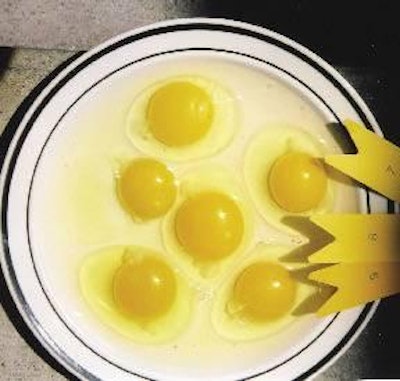
Marketing studies show that consumers associate intensity of yolk color with "freshness of eggs," "health of producing flocks," and "wholesome feeding." Producers of generic eggs in the United States are generally content to accept the color of yolks as produced by flocks with minimal monitoring and rely on tabular xanthophyll values in feed formulation to achieve minimal standards. In contrast, producers of specialty eggs strive for uniform and deep coloration consistent with higher client expectations.
Travelers to Europe observe that eggs have darker and more orange yolk hues than those in the United States. This is due in large measure to supplementing diets with synthetic carotenoids which are permitted under European Union (EU) regulations. In the United States, addition of these compounds, which are chemically identical to their natural analogues, is disallowed as it is regarded as a deceptive practice in terms of U.S. Food and Drug Administration (FDA) regulations. Producers in the United States are required to use only natural pigmenting agents, which are derived from vegetable sources, although the active components are concentrated by extraction and purification.
The second component of yolk intensity relates to the specific health benefits correlated to the level of xanthophylls which comprise mainly lutein and zeaxanthin. Informed consumers are responding to advice provided by dieticians and specialists in ocular and vascular medicine to increase their intake of these pigments.
Sources and Types of Egg Yolk Pigments
The xanthophyll pigments are terpene compounds structurally derived from betacarotene. The most commonly encountered xanthophylls are lutein and zeaxanthin, both of which impart a yellow color to yolks. Cryptoxanthine and canthaxine, in contrast, are red pigments. Xanthophylls are fat-soluble compounds, absorbed most efficiently from the intact intestine. They are transported by lipoproteins and are either stored in fat or deposited in the yolk of eggs. Hens are capable of metabolizing absorbed xanthophylls to produce a range of analogues by displacement and substitution of hydroxyl and ketone groups.
The stability of xanthophylls is affected by exposure to oxygen and ultraviolet light. A reduction of 2 percent to 5 percent in biological activity occurs during each month of storage unless premixes are stabilized with an effective antioxidant. The rate of degradation in natural ingredients is fairly rapid and this can lead to suboptimal levels in corn, the major contributor of natural xanthophylls in layer diets within four months after harvest. This has direct implications in formulating diets since tabular values of xanthophyll content for corn, which may be applicable in October and November, may be unrealistically high for the ingredient stored through to the August following harvest.
Quantifying total xanthophyll levels in ingredients, feed and yolk should follow the Association of Official Agricultural Chemists (AOAC) methods. Carotenoids are assayed using a sequence of saponification followed by hexane extraction and then determining the concentration of the specific compounds present applying highpressure liquid chromatography. It is possible to distinguish between lutein and translutein and other xanthophylls and also to distinguish between transzeaxanthin and related compounds applying this technology.
The chemical structures of the significant xanthophylls demonstrates the minor differences in the position of hydroxyl groups and oxygen which determine color and related properties. The ability of ingredients to impart color to yolks is a function of xanthophyll content at the time of ingestion and is influenced by the digestibility of these compounds. Chronic enteritis or parasitism (capillariasis), especially in non-confined flocks, may result in pale yolks despite adequate dietary levels of xanthophylls. Lutein is generally less available than zeaxanthin which influences yolk color in relation to nutritional formulation and the expenditure on pigmenting additives.
Synthetic carotenoids are available in Europe and are permitted in terms of EU regulations. Carotenoids are analogues of compounds that exist in natural feedstuffs. A widely used commercial product, beta-apo-8-carotenal, is in fact an intermediate in the degradation of betacarotene to vitamin A. The synthetic carotenoids are nontoxic and are extensively used in Asia, the EU, and Latin America, attesting to safety and efficacy. It is unfortunate that FDA has deemed these products from reputable multinational manufacturers to be adulterants.
The major sources of xanthophylls in diets for laying hens include corn, corn gluten meal, and dehydrated alfalfa meal. The xanthophyll content of these ingredients is shown in Table 1. Specific assays for lutein and zeaxanthin in U.S. ingredients and in feed are shown in Table 2. Variability in the carotenoid composition of ingredients contributes to variation in the intensity of yolk color produced by hens fed similar diets at different times of the year.
Egg yolk color is usually measured under field conditions using a series of standard reference colors printed onto narrow plastic strips arranged in a fan. A numerical score is assigned each "blade" although it is noted that two commercial suppliers of pigmenting additives issue color fans which differ by at least one unit in numerical scoring. Evaluating yolk color by subjective assessment using a comparison fan requires natural daylight and a white background. False readings can be obtained under fluorescent lighting or if operators have defective color perception.
Electronic instruments are available to determine yolk color. The Orka Egg Tester simultaneously provides a reading of yolk color intensity according to the Roche/DSM scale, Haugh units and United States Department of Agriculture grade. Research laboratories use sophisticated colorimeters.
Commercially-Available Pigmenting Additives
Natural pigment supplements are extracted from marigold petals (Tagetes erecta) to increase the intensity of yellow-gold color of yolks. Extracts of red peppers and paprika (Capsicum spp.) provide a red hue to yolks. Red and yellow pigments are frequently combined to achieve a desired yellow-orange color and to take advantage of the synergistic activity of commercial supplements since the respective lutein and capsanthin components are mutually complementary. Supplements for commercial layers are usually added in dry form as a microingredient to diets. Levels range from 0.5 lbs. to 2 lbs. per ton depending on the xanthophyll contribution of natural ingredients, level of yolk intensity required, and the cost-effectiveness of supplementation.
Paprika, pepper or marigold petals are harvested and are processed by milling, extraction of the pigment as an oleoresin followed by saponification. This process releases the xanthophyll components from the fatty acid ester form, facilitating subsequent absorption in the intestinal tract. There is a high correlation between the degree of saponification, which should range from 95 percent to 100 percent and subsequent intensity of color, irrespective of the chemical assay for the presence of xanthophyll compounds.
In a typical dry yellow commercial pigmenter, xanthophyll content is approximately 20 ppm (mg/kg) with 80 percent of the xanthophylls in the form of lutein and approximately 6 percent as zeaxanthin. In contrast, red pigmenting additives assayed at 20 ppm content contain at least 50 percent capsanthin and a correspondingly low level of lutein.
Commercial pigmenting additives comprise the active and refined extracts blended with an inert vegetable or mineral carrier, a drying agent such as silicon dioxide, propylene glycol and ethoxyquin as an antioxidant. To maintain the stability of the xanthophylls, one EU manufacturer packs product in aluminum foil-lined bags with air-tight seals which allow exclusion of air by flushing with nitrogen to maintain potency.
The beneficial effect of combining red and yellow pigmenters on egg yolk color is demonstrated in Table 3, showing the effect of supplementing a wheat-based diet devoid of xanthophylls. Adding a red pigment to a similar quantity of yellow supplement almost doubled the yolk color score.
A dietary xanthophyll content of approximately 40 mg/kg is required to achieve an acceptable Roche/DSM score of 7.5 to 8.0. With a diet containing 70 percent newly-harvested corn, all the xanthophyll required for pigmentation would be present. If old corn is used, xanthophyll content may decline from a high of 50mg/kg to as low as 25 mg/kg. The resulting diet would contain only 18 mg/kg xanthophyll and would therefore require 1.5 lbs. to 2 lbs. of a commercial pigmenting additive (containing 15 mg/kg) to restore xanthophyll content to a level consistent with acceptable yolk color.
It is therefore essential to evaluate the cost of any additive based on the xanthophyll contribution. Natural sources of xanthophylls include corn gluten meal (60 percent protein) which contributes 300 mg/kg; corn gluten feed (40 percent protein) which can range from 100 to 200 mg/kg; and dehydrated alfalfa meal ranging from 200 to 350 mg/kg, depending on composition and processing.
In evaluating the xanthophyll requirement for nutreceutical eggs with special label claims, higher levels of yellow pigmenting additives are required to boost lutein content. Assays show that hens fed conventional diets produced yolks with a total xanthophyll content of 150 micrograms. Assuming a dietary content of 40 mg/kg and an intake of 100 grams per day (22 lbs./100 hens/day), an intake of 4 milligrams per hen represents only a 4 percent efficiency of deposition of dietary xanthophylls into egg yolk.
Contribution of Xanthophylls to Human Health
Dieticians affiliated with the Egg Nutrition Center have reviewed available peer-reviewed scientific literature confirming the value of regular consumption of eggs in preventing age-related macular degeneration, promoting the integrity of skin and the possibility of reducing the incidence rate of certain cancers. The common factor to the health promoting attributes of eggs relate to the antioxidant properties of lutein, which is a vital component of cell membranes, which must be protected against peroxidation by free radicals.
Lutein and zeaxanthin are found in the macula lutea (yellow spot) of the retina. These pigments absorb the ultraviolet portion of the light spectrum entering the eye, protecting the sensitive receptor cells in the macula. It is estimated that age-related macular degeneration (ARMD) affects more than 5 percent of the U.S. population over 65 and this condition is a leading cause of blindness in senior citizens.
Studies conducted at health research institutes have demonstrated that consumption of an egg each day by a susceptible group of volunteers increased the density of pigment in the macula without increasing serum cholesterol.
Current intake of lutein in the average adult diet is in the region of 1 mg to 2 mg of lutein daily, mainly provided by leafy vegetables. Adding an egg containing adequate levels of lutein to diets will increase the intake of this critical nutrient to prolong visual acuity. The ability of lutein to absorb ultraviolet light and thereby inhibit formation of free radicals elaborated from lipid peroxidation, has a parallel application to protect the dermal layers of skin in people exposed to intense sunlight over protracted periods. Increasing lutein and zeaxanthin intake reduces the probability of developing basal cell carcinoma and possibly melanoma.
Take Home Message
Health and marketing considerations should stimulate greater concern in formulating feed to achieve desired xanthophyll levels. Cost effectiveness of additives must be evaluated in terms of producing yolks with desired color required by specific market segments willing to pay for the perceived attribute of intense yellow pigmentation and lutein content.


.jpg?auto=format%2Ccompress&fit=crop&h=167&q=70&w=250)

.png?auto=format%2Ccompress&fit=crop&h=167&q=70&w=250)











